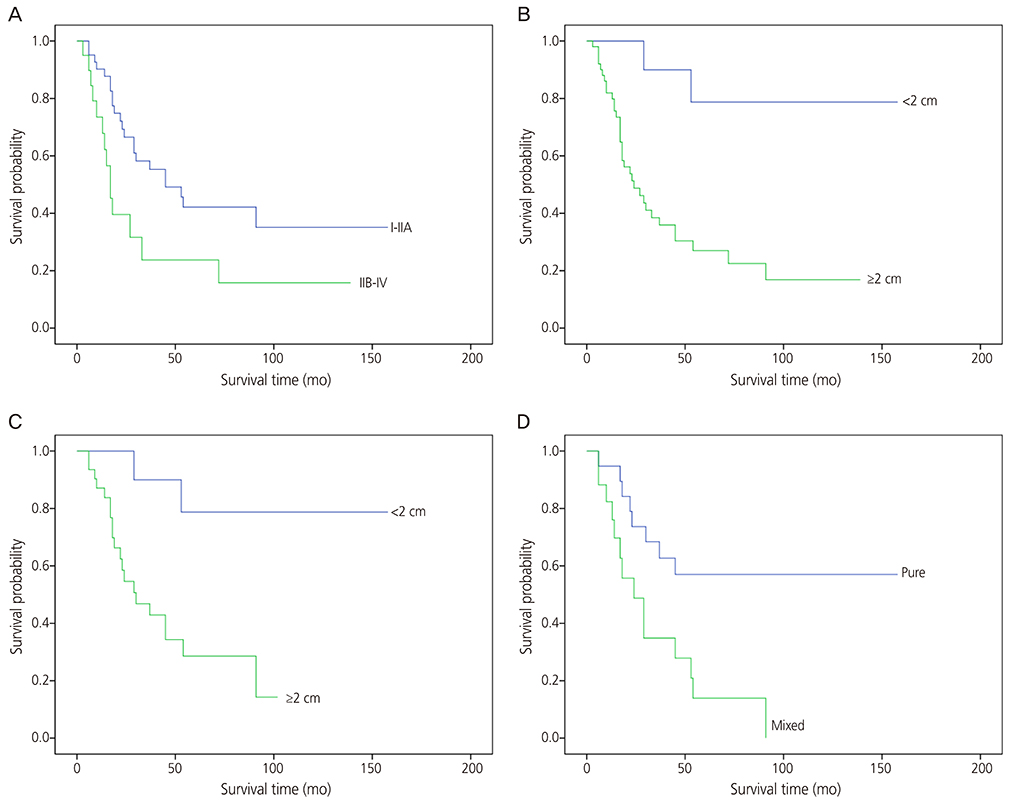Obstet Gynecol Sci.
2016 Mar;59(2):116-122. 10.5468/ogs.2016.59.2.116.
Prognostic factors in neuroendocrine cervical carcinoma
- Affiliations
-
- 1Department of Obstetrics and Gynecology, Seoul National University Hospital, Seoul, Korea. marialeemd@gmail.com
- 2Department of Obstetrics and Gynecology, Seoul National University College of Medicine, Seoul, Korea.
- 3Center for Uterine Cancer, Research Institute and Hospital, National Cancer Center, Goyang, Korea.
- KMID: 2159006
- DOI: http://doi.org/10.5468/ogs.2016.59.2.116
Abstract
OBJECTIVE
To evaluate the clinical and pathologic factors associated with survival in patients with neuroendocrine cervical carcinoma (NECC).
METHODS
The records of 61 patients with NECC diagnosed between 2000 and 2014 at Seoul National University Hospital and the National Cancer Center were retrospectively reviewed. Kaplan-Meier and Cox regression methods were used for analyses.
RESULTS
Of the 61 patients, 67.2% were diagnosed at early stage (I to IIA) with a median age of 49 years. Of those, 78% underwent surgery and 75.6% received postoperative adjuvant treatment. For patients diagnosed at advanced stage, 60.0% received chemotherapy only and 25.0% received concurrent chemoradiation therapy. In the univariate analysis, advanced stage (77 vs. 40 months, P=0.013), tumor size ≥2 cm (133 vs. 47 months, P=0.002) and mixed tumor (101 vs. 34 months, P=0.004) were shown to be poor prognostic factors. In the multivariate analysis, tumor stage, tumor size and tumor homology were shown to be independent prognostic factors for overall survival. Of the total, 39.3% of the patients experienced recurrence, and 54.1% of the patients had metastasis. Of the patients diagnosed at early stage, 51.2% experienced recurrence.
CONCLUSION
Tumor stage, tumor size and tumor homology were found to be independent prognostic factors in patients with NECC. Even in patients diagnosed at early stage, recurrence and distant metastasis were frequently observed.
Keyword
MeSH Terms
Figure
Reference
-
1. Albores-Saavedra J, Gersell D, Gilks CB, Henson DE, Lindberg G, Santiago H, et al. Terminology of endocrine tumors of the uterine cervix: results of a workshop sponsored by the College of American Pathologists and the National Cancer Institute. Arch Pathol Lab Med. 1997; 121:34–39.2. Gardner GJ, Reidy-Lagunes D, Gehrig PA. Neuroendocrine tumors of the gynecologic tract: a Society of Gynecologic Oncology (SGO) clinical document. Gynecol Oncol. 2011; 122:190–198.3. Delaloge S, Pautier P, Kerbrat P, Castaigne D, Haie-Meder C, Duvillard P, et al. Neuroendocrine small cell carcinoma of the uterine cervix: what disease? What treatment? Report of ten cases and a review of the literature. Clin Oncol (R Coll Radiol). 2000; 12:357–362.4. Viswanathan AN, Deavers MT, Jhingran A, Ramirez PT, Levenback C, Eifel PJ. Small cell neuroendocrine carcinoma of the cervix: outcome and patterns of recurrence. Gynecol Oncol. 2004; 93:27–33.5. Hoskins PJ, Swenerton KD, Pike JA, Lim P, Aquino-Parsons C, Wong F, et al. Small-cell carcinoma of the cervix: fourteen years of experience at a single institution using a combined-modality regimen of involved-field irradiation and platinum-based combination chemotherapy. J Clin Oncol. 2003; 21:3495–3501.6. Chen TC, Huang HJ, Wang TY, Yang LY, Chen CH, Cheng YM, et al. Primary surgery versus primary radiation therapy for FIGO stages I-II small cell carcinoma of the uterine cervix: a retrospective Taiwanese Gynecologic Oncology Group study. Gynecol Oncol. 2015; 137:468–473.7. Lee JM, Lee KB, Nam JH, Ryu SY, Bae DS, Park JT, et al. Prognostic factors in FIGO stage IB-IIA small cell neuroendocrine carcinoma of the uterine cervix treated surgically: results of a multi-center retrospective Korean study. Ann Oncol. 2008; 19:321–326.8. Tsuchiya R, Suzuki K, Ichinose Y, Watanabe Y, Yasumitsu T, Ishizuka N, et al. Phase II trial of postoperative adjuvant cisplatin and etoposide in patients with completely resected stage I-IIIa small cell lung cancer: the Japan Clinical Oncology Lung Cancer Study Group Trial (JCOG9101). J Thorac Cardiovasc Surg. 2005; 129:977–983.9. Cohen JG, Kapp DS, Shin JY, Urban R, Sherman AE, Chen LM, et al. Small cell carcinoma of the cervix: treatment and survival outcomes of 188 patients. Am J Obstet Gynecol. 2010; 203:347.e1–347.e6.10. Deacon JM, Evans CD, Yule R, Desai M, Binns W, Taylor C, et al. Sexual behaviour and smoking as determinants of cervical HPV infection and of CIN3 among those infected: a case-control study nested within the Manchester cohort. Br J Cancer. 2000; 83:1565–1572.11. Chan JK, Loizzi V, Burger RA, Rutgers J, Monk BJ. Prognostic factors in neuroendocrine small cell cervical carcinoma: a multivariate analysis. Cancer. 2003; 97:568–574.12. Chang TC, Lai CH, Tseng CJ, Hsueh S, Huang KG, Chou HH. Prognostic factors in surgically treated small cell cervical carcinoma followed by adjuvant chemotherapy. Cancer. 1998; 83:712–718.13. Bermudez A, Vighi S, Garcia A, Sardi J. Neuroendocrine cervical carcinoma: a diagnostic and therapeutic challenge. Gynecol Oncol. 2001; 82:32–39.14. Huang L, Liao LM, Liu AW, Wu JB, Cheng XL, Lin JX, et al. Analysis of the impact of platinum-based combination chemotherapy in small cell cervical carcinoma: a multicenter retrospective study in Chinese patients. BMC Cancer. 2014; 14:140.
- Full Text Links
- Actions
-
Cited
- CITED
-
- Close
- Share
- Similar articles
-
- The Prognostic Significance of Neuroendocrine Differentiation for Treating Prostatic Carcinoma in 699 Cases of Radical Prostatectomy
- A Case of Mixed Small and Large Cell Neuroendocrine Carcinoma of the Uterine Cervix
- Large cell Neuroendocrine Carcinoma Associated with Invasive Mucinous Adenocarcinoma of the Uterine Cervix
- A case of mixed type large cell neuroendocrine carcinoma of the uterine cervix
- Skin Metastasis of Neuroendocrine Carcinoma Arising in the Uterine Cervix


